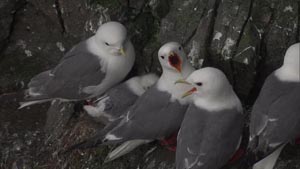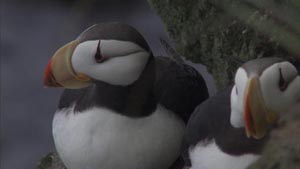
Topics










|
Island Natural Resources
Birds
The Pribilof Islands are also known for their bird populations. A special 10th anniversary issue of WildBird listed the Pribilof Islands as one of the top ten birding locations in North America (Konrad 1996). Kent Sundseth (K. Sundseth 2005, pers. comm.), a refuge operations specialist for the U.S. Fish and Wildlife Service, Alaska Maritime National Wildlife Refuge, provided the following information, which elucidates the reasons for such recognition.
An estimated 2.7 million seabirds migrate to the Pribilofs each summer to hatch and raise their young. About 2.5 million use St. George Island, which has eight times more cliff area than St. Paul Island. Well over 200 species of birds have been recorded in the Pribilof Islands, though more exact figures vary. Thirteen species of seabirds are known to nest in the Pribilofs (See table below). The most numerous include: thick-billed murre (Uria lomvia), common murre (Uria aalge), red-legged kittiwake (Rissa brevirostris), black-legged kittiwake (Rissa tridactyla), least auklet (Aethia pusilla) (known locally as the “choochkie”), crested auklet (Aethia cristatella), parakeet auklet (Aethia psittacula), tufted puffin (Fratercula cirrhata), horned puffin (Fratercula corniculata), red-faced cormorant (Phalacrocorax urile), and northern fulmar (Fulmarus glacialis). Other seabird species recorded in small numbers, but not necessarily breeding on the islands every year are the pelagic cormorant (Phalacrocorax pelagicus) and glaucous-winged gull (Larus glaucescens). St. George Island’s murre colony is the largest in Alaska with 1.5 million thick-billed murres. The U.S. Fish and Wildlife Service estimated that 80 percent of the world’s red-legged kittiwake population nests on St. George Island. The winter wren (Troglodytes troglodytes), snow bunting (Plectrophenax nivalis), and gray-crowned rosy finch (Leucosticte tephrocotis) are three species of passerine birds (or songbirds) that nest in the Pribilof Islands and are year-round residents. The Lapland longspur (Calcarius lapponicus) migrates to the islands to nest each summer. A unique subspecies of shorebird, the Pribilof rock sandpiper (Calidris ptilocnemis ptilocnemis), also nests on the islands. Common ravens (Corvus corax) are suspected of nesting on St. George Island in recent times, though this has not been documented. (Kent Sundseth, USFWS, 2005)
Number of Adult Breeding
Seabirds Observed on the Pribilof Islands, Alaska
Species |
St. George Island |
St. Paul Island |
Otter Island |
Walrus Island |
| Northern Fulmar (Fulmaris glacialis) |
53,980 |
1,500 |
83 |
|
| Red-faced Cormorant (Phalacrocorax urile) |
5,000 |
2,500 |
40 |
42 |
| Glaucous-winged Gull (Larus glaucescens) |
1* |
1* |
|
|
| Black-legged Kittiwake (Rissa tridactyla) |
62,568 |
18,140 |
2,096 |
100 |
| Red-legged Kittiwake (Rissa brevirostris) |
193,930 |
1,175 |
338 |
|
| Common Murre (Uria aalge) |
201,913 |
14,243 |
1* |
1,021 |
| Thick-billed Murre (Uria lomvia) |
1,098,600 |
76,065 |
1* |
50 |
| Unidentified Murre (Uria spp.) |
|
|
12,800 |
|
| Parakeet Auklet (Aethia psittacula) |
150,000 |
34,000 |
1* |
20 |
| Least Auklet (Aethia pusilla) |
250,000 |
23,000 |
1* |
300 |
| Crested Auklet (Aethia cristatella) |
28,000 |
6,000 |
1* |
1* |
| Tufted Puffin (Fratercula cirrhata) |
6,000 |
1,000 |
1* |
|
| Horned Puffin (Fratercula corniculata) |
28,000 |
4,400 |
1* |
2 |
| Total Cormorant (all cormorant species combined) |
5,000 |
2,500 |
40 |
42 |
| Total Murre (all murre species combined) |
1,300,513 |
90,308 |
12,800 |
1,071 |
| Total of all species combined |
2,077,991 |
182,023 |
15,357 |
1,535 |
*Species was spotted at this
location but is rare and uncounted.
Source: U.S. Fish and Wildlife Service Beringian Seabird Colony Catalog (2005). The USFWS frequently updates the catalog. The source and year of the data in the table may vary.
St. George and St. Paul Islands are two of nine annual ecological monitoring sites in the Alaska Maritime National Wildlife Refuge. Bird counts from 1976 to 2002 indicate red-legged kittiwakes and thick-billed murres on St. George Island experienced significant declines during the late 1970s and 1980s followed by modest but steady increases from the mid 1990s to the present (Renner and Howard 2003; Thomson 2005). On St. Paul Island, red-legged and black-legged kittiwakes experienced declines from 1976 through the late 1990s (Renner and Howard 2003). Common murres and thick-billed murres declined from 1976, possibly leveling or increasing after 2000. The reason for the seabird declines is not entirely clear, but scientific studies suggest it is linked to prey availability and quality (Hunt and Byrd 1999; Kitaysky et al. 2005).
Click here to view a video of
seabirds on St. George Island
Click here to view a video of seabird research activities

Red-legged kittiwakes on St. George Island (NOAA).
A saltwater lagoon, known as the Salt Lagoon, on St. Paul Island, is an important and unique component of the Pribilof ecosystem. The Salt Lagoon is the only shallow, tidal-driven habitat in the Pribilof Islands, with substantial tide flats exposed during low water. The tide flats serve as foraging areas for shorebirds such as the Pribilof rock sandpiper and ruddy turnstones (Arenaria interpres) (Flint et al. 1999, 1). The lagoon’s location near the edge of the eastern continental shelf and about 300 miles from the continental shore of Alaska makes it important habitat for migratory waterfowl.
Kiril Timofeevich Khlebnikov (Pierce 1994, 274–277) and William Palmer (1899) provide early and late nineteenth-century accounts of Pribilof birds, respectively. Khlebnikov described fifteen types of birds. Palmer provided a list of sixty-nine bird species observed on the Pribilof Islands.

Horned puffins on St. George Island (NOAA).
Geology
Flora
Marine Mammals
Land Mammals
Domestic Animals
Marine Invertebrates
Insects and Arachnids
Fossils
|


